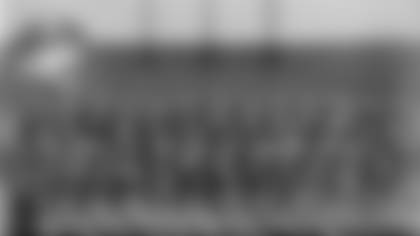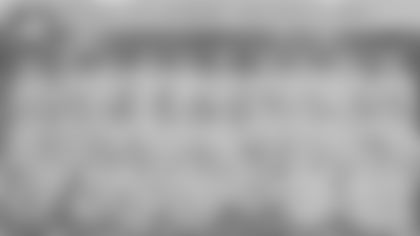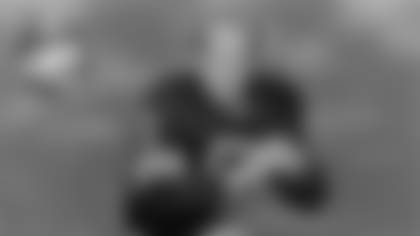Jim from Green Bay
The 1950s were lean years for the Packers and most players from that era have been long forgotten. However, there was a strong defensive player named Roger Zatkoff. What type of career did Zatkoff have while in Green Bay and throughout his years in the NFL? I met Mr. Zatkoff on a cold Saturday afternoon in 1996 at "Old" City Stadium. I was about to walk into Green Bay East High School to work at a varsity basketball game when a gentleman in his car rolled down his window and asked: "Do you know when they dismantled the stadium?" I told him I had no idea, but I had a picture with an aerial view of City Stadium in my office and asked if he would like to see it. When I showed Zatkoff the picture of the stadium, he pointed and said: "There it is! That's what I wanted to see. The white fence. That was a 2x6 fence that circled the whole football field. If you could hit someone through that fence, you got a free round of drinks that night from the boys." I noticed his eyes were welling up when he was telling his story, which prompted me to ask, "Did you play for the Packers?" He said yes and that his name was Roger Zatkoff. Then he humbly said, "I'm here on business." The next day I attended the Packers-Broncos game at Lambeau Field, and he was the honorary captain. He wasn't on a business trip. He came to Green Bay as an honorary captain. I then mailed the picture of City Stadium to him, and he sent me a picture, his football card and a story about how when he played for Detroit, he wore cowbells during practice. The story he sent said that Lions linebacker Roger "Zany" Zatkoff hit with such ruthless abandon that his own teammates decided in 1957 that for their own safety, they'd make him wear a set of cowbells in scrimmages so they could hear him coming.

Jim, thanks for sharing your entertaining stories about one of the most intense and intimidating defenders in Packers history. Your question might make for better reading than my answer.
First, here's a summary of Zatkoff's NFL career.
After being selected by the Packers in the fifth round of the 1953 NFL Draft, Zatkoff played four years in Green Bay, mostly as an outside linebacker. He was named to the Pro Bowl the last three of those seasons, 1954-56, and also received first- or second-team all-pro mention in each of those seasons.
In 1954, Zatkoff was chosen first team by United Press based on a league-wide vote of sportswriters and the Newspaper Enterprise Association team, which was based on balloting conducted by widely respected pro football authority Murray Olderman. In 1955, Zatkoff made the Associated Press first team, which was picked by sportswriters; and was second-team NEA, when Olderman sent ballots to 396 NFL players. NEA's first-team linebackers were future Pro Football Hall of Famers Joe Schmidt and George Connor. Again in 1956, Zatkoff was named second team NEA behind future Hall of Famers Schmidt and Chuck Bednarik. At the time, the NEA selected a middle guard and only two linebackers on its all-pro team.
That alone makes for an impressive resume considering the Packers had a composite record over Zatkoff's four seasons of 16-31-1.
However, when the 1956 season ended, Zatkoff, although only 25 years old, announced he planned to retire. Weeks later, he requested a trade to Detroit so he could launch a business career while still playing. Zatkoff was a native of the Detroit area and a product of the University of Michigan.
On April 19, 1957, Packers coach Lisle Blackbourn traded Zatkoff and backup quarterback Bobby Garrett to Cleveland for six players, including quarterback Babe Parilli. Blackbourn wanted no part of facing Zatkoff twice a season as a member of Western Conference-rival Detroit. But as it turned out, Zatkoff balked at playing for the Browns and got his wish. He was traded again to the Lions for halfback Lew Carpenter less than three weeks before the '57 season opener.
Zatkoff played two more seasons in Detroit and was a key defender when the Lions won their last NFL championship in 1957. "He's the hardest tackler on the team," defensive coach Buster Ramsey said before the final game of the regular season. "Roger may not be as agile as some of our defensive men, but he helps make our linebacking trio as good as any we've ever had – maybe better."
Zatkoff, who was listed at 6-foot-2 and 216 pounds, retired following the 1958 season due to bad knees and started his own company in Farmington, Mich.
The picture of Zatkoff standing over Pittsburgh receiver Ray Mathews was from the 1954 season opener. There was fear Mathews had suffered a serious injury when he collided with the fence, and it was a memorable moment often repeated when I was growing up in Green Bay in the 1950s. I always heard that Mathews ran into the fence, but there could have been more to the story and Zatkoff's involvement. If so, I'm not aware of it.
As far as I can determine the cowbell story was first told by Lions quarterback Bobby Layne in a 1964 magazine story where he talked about the meanest players in the game. In a story I found, the columnist wrote: "In workouts during the course of a season, (Zatkoff) sidelined three defensive backs on his team at Detroit. The others got so jumpy they made Zatkoff wear a cowbell during scrimmage."
None of what you wrote surprised me. In my interviews with players from the 1950s, many of them spoke in awe of Zatkoff's toughness.
Here was what some of them told me:
Pro Football Hall of Fame safety Bobby Dillon: "We called him 'Zany' Zatkoff. He was good. A lot of times people laughed at him, he tried so hard. But he'd knock the heck out of you. I remember playing Detroit one time, and he intimidated Leon Hart (a 6-5, 257-pound end and fullback) so bad that Leon Hart wasn't worth a damn the whole game. Every play, Roger would hit him whether he had the ball or didn't have the ball. (Hart) started crying to the referee. (Zatkoff) would just antagonize him and old Hart lost his composure completely. Then when (Hart) carried the ball, Roger really laid it on."
Packers Hall of Fame linebacker Deral Teteak: "Roger was a wild guy. His motor was going 100 miles an hour all the time. A good player. Strong. He was wild on the field. Off the field, I don't even think he'd drink anything. He was just wild: a sideline-to-sideline guy."
End Gene Knutson, a Beloit, Wis., native and college teammate who played for the Packers in 1954 and again in '56: "One of the best Green Bay Packers who ever played. He was a tremendous player. Brutal. He could hit with the best of them. They called him 'Zany.' He was a nice guy, a family guy, but on the football field, he liked to deck you. At Michigan, he was one of the most underrated damn college football players of all time. He could hit like no one else could hit."
Former Packers GM Ron Wolf also told me this: "I had the opportunity to work with Dave Hanner (who played defensive tackle for the Packers from 1952-64) when I got here in the scouting department. Dave Hanner is not the kind of guy to hand out platitudes. But when he talked about Roger Zatkoff, he had a special look on his face, his voice inflexion changed and he'd say, 'He was tough. He was really a good football player.' He was an exceptional player. The Pro Bowls tell you how good he was."
Steve from Liverpool, Nova Scotia, Canada
I've always been a Packers fan and I believe Bill Forester was underrated as a player. According to the book "Lombardi's Left Side," Dave Robinson indicated that Forester played an important role in helping him adjust to playing in the NFL. Has Forester ever been considered for the Hall of Fame? I know he played the right linebacker position for Lombardi. What positions did he play before Lombardi came to Green Bay? I believe being selected all-pro from 1960 to 1962 is impressive considering he was at the end of his playing career.
You're right about Forester being an outstanding player and someone deserving of being part of the discussion about the best outside linebackers of the 1950s and '60s.
Rather than summarize his career again, here's a link to his Packers Hall of Fame bio on our website.
When I was on the Pro Football Hall of Fame selection committee from 2001-14, there was occasional discussion about the most deserving outside linebackers from Forester's era and who among them were possible senior candidates.
Forester played 11 years, never missed a game and was a four-time Pro Bowl choice in his first four seasons playing for Lombardi. He also was defensive captain of two NFL championship teams.
What's more impressive is that Forester was a consensus all-pro all four years, as well.
In 1960, he made the AP and UPI teams, and was second-team NEA when its selections were determined by leaguewide balloting of all NFL players. In '61, Forester was chosen again by both AP and UPI, the two wire service teams, and again second-team NEA. In '62, Forester made all three of the major teams: AP, UPI, and NEA. What's more, Forester was a second-team New York Daily News selection in 1959, when that newspaper also polled sportswriters across the league; and a UPI first team and NEA second team choice in 1963.
In other words, Forester was really a five-time, first-team all-pro when counting all three of the most publicized teams: AP, UPI and NEA. Now, let's compare that with other outside linebackers from that period who seem to have been given more Hall of Fame consideration than Forester.
Dallas' Chuck Howley, who was inducted into Canton last year, played 13 years plus four other games between 1958 and '73. He was a six-time Pro Bowl pick and five-time AP All-Pro. Those are slightly better numbers than Forester. However, there was a vast disparity between the NFL's Western and Eastern Conferences before the 1970 merger in terms of talent and strength of teams.
From 1957-69, the Western Conference champs won 11 of 13 NFL titles.
Remarkably, only Cleveland and the New York Giants of the seven Eastern teams had more winning seasons than non-winning seasons during that stretch. Washington, Pittsburgh, Philadelphia and the then St. Louis Cardinals combined for 14 winning seasons out of a possible 52. Dallas, which entered the league in 1960, had only four winning seasons over a total of 10.
The Browns finished with a winning record all 13 years. The Giants had a streak of seven winning seasons from 1957-63 and then failed to finish over .500 in any of the next six.
Basically, the competition for Pro Bowl berths in the East boiled down to players on losing teams other than those who played for the Browns, the Giants from 1957-63 and the Cowboys from 1966-69.
Back to Forester's contemporaries at outside linebacker.
Maxie Baughan played 11 seasons plus two other games between 1960 and '74 basically for Philadelphia and the Los Angeles Rams. He made AP first-team once and was a nine-time Pro Bowl pick, including five with the Eagles in the weaker Eastern Conference.
The Baltimore Colts' Don Shinnick played 13 years from 1957-69. While Shinnick was never named first-team all-pro or made a Pro Bowl, the Pro Football Reference website lists him on its 1960s all-decade second-team as a linebacker ahead of Forester.
Detroit's Wayne Walker was on Pro Football Reference's 1960s first team. He played 15 years, made AP first-team all-pro once, never made NEA first team and was selected to three Pro Bowls.
The Chicago Bears had two outstanding outside linebackers: Joe Fortunato, who played 12 years from 1955-66 and missed one game; and Larry Morris, who played seven of his 11 seasons with the Bears. Fortunato was named AP first-team All-Pro three times and was named to five Pro Bowls. Overshadowed by Fortunato for good reason, Morris was better than most of the outside backers of his day but never made AP first-team All-Pro or a Pro Bowl and missed 20 games during his career.
Even San Francisco's Dave Wilcox, who was inducted into the Pro Football Hall of Fame in 2000, was named first-team only twice by both AP and NEA.
Steve, to be honest, I'm not going to make a case that Forester should be in the Pro Football Hall of Fame. I think there are other Packers more deserving, starting with Verne Lewellen.
But what I find mind-boggling is how voters and website staffers think they know more about long-ago players than the players themselves from those eras and also the writers who covered them.
The Pro Football Hall of Fame selection committee's only all-decade outside linebacker in the 1950s was Fortunato. The other three linebackers on the team all played in the middle: Hall of Famers Bill George, Sam Huff and Joe Schmidt. In the 1960s, five linebackers were chosen: Green Bay's Dave Robinson and Morris on the outside; and Dick Butkus, Ray Nitschke and Tommy Nobis in the middle.
I don't put a lot of stock in all-decade teams. For example, Morris was certainly a curious choice, considering he was never named AP or UPI first-team all-pro, teams that were selected by some and maybe most of the same sportswriters who voted for the 1960s all-decade team.
My guess would be that because Fortunato was named to the 1950s all-decade team, voters decided to put Morris on the 1960s team. Considering even in 1963, when the Bears won the NFL title with defense and Morris made second-team all-pro for the only time in his career, Fortunato was the first-team choice by AP, UPI, and NEA. Morris made second team on all three.
Of all the outside linebackers from the 1950s and '60s that I've mentioned up to this point, I'd rate Robinson the best and Fortunato second based on the most credible of the postseason honors and interviews with players from that period. I'd pick Fortunato over not only Forester, but Howley and maybe even Wilcox.
In truth, the Packers had 12 all-decade players in the 1960s, including two of the five linebackers: Nitschke and Robinson. Thus, my guess would be that the selectors chose Morris and overlooked Forester to avoid being accused of Packers overkill. On the surface that seems illogical. But, admittedly, if they had chosen Fortunato rather than Morris, I wouldn't blame them.
Rather than all-decade teams, what I pay close attention to are the Pro Bowl selections and the NEA all-pro teams because as the great Oakland center Jim Otto explained in 1972: "The coaches pick the Pro Bowl teams, and I consider it a real honor to be selected. I also feel it was an honor to be named again to the NEA all-pro team because the players themselves vote on that."
Let's start with 1959, when the NFL head coaches who picked the Pro Bowl teams and the hundreds of players who chose the NEA all-pro team picked three linebackers rather than two and a middle guard on their teams. It also marked Lombardi's first season as Packers coach and Forester's third as an outside linebacker after playing middle guard for four years.
Likewise, let's end with the 1969 season, the last before the AFL-NFL merger was finalized and also the last where the two leagues played separate all-star games.
What follows are the outside linebackers who were named to the most Pro Bowls during those 11 seasons. Keep in mind both the Pro Bowl teams and NEA all-pro teams were dominated by middle linebackers before a distinction was drawn between middle and outside linebackers. For example, in the 1961 Pro Bowl, three of the four linebackers on the West squad played in the middle with Forester being the exception.
The NEA started picking one middle linebacker and two outside linebackers on its all-pro team for the first time in 1962. That same season, three of the four linebackers for the West team in the Pro Bowl played on the outside, including Forester, Fortunato, and Matt Hazeltine of San Francisco.
Most Pro Bowls (1959-69): Baughan, 9; Fortunato, 5; Forester, 4; Howley, 4; John Reger, Pittsburgh, 3 (1960-62); Walker, 3; Hanburger, 3.
Most NEA first-team all-pro honors (1959-69): Dan Currie, Green Bay, 3 (1961-63); Fortunato, 3; Robinson, 3; Howley, 3.
(Notes: Currie appeared destined for greatness until he fell victim to a blindside cheap shot to his left knee late in the 1962 season and was never the same player. The only other outside linebacker in the entire league to be selected three times to either the NEA's first- or second-team was Forester with one first-team selection and two second teams. In fact, in 1962, which was arguably the best of Lombardi's championship teams, linebacker was considered the strength of the defense and the NEA's two first-team outside backers were Currie and Forester.)
Josh from Wilmington, DE
I believe we are all acutely aware that it is a longshot at best for some of our beloved Packers to have real HOF considerations, and I don't think I need to rehash all your recent articles here. If there was something we could do, what would it be? Is there a person or committee we can write to? Are there any bylaws in the HOF for these players to gain entry or increase their chances? It almost seems if you are not featured on NFL Films or an ESPN 30 for 30 you have no shot at being nominated. Maybe I am writing to the wind here, however I was flipping through all your old postings and wanted to write in and share my pipedream.
Thanks for your sincere offer.
But to be honest, I avoided campaigning for Packer players when I was on the Hall of Fame's selection committee and still wouldn't endorse the idea.
Like Deion Sanders, I think for the most part those campaigns when successful lower the standard for induction. There certainly was a much higher standard for players in the 1920s, '30s and maybe into the '60s than there are for more recent players.
I plead guilty for my pitches to get Lewellen into the Hall of Fame. But I consider him an anomaly.
I'm guessing very few very members of even the senior committee realize that if a blue-ribbon committee of say Curly Lambeau and five to 10 players who played in the 1920s and then remained in Green Bay and closely followed the team through Lambeau's final season in 1949 might have chosen Lewellen as the greatest Packer of all-time up to that point. That's based on quotes that I've read from players who would have been candidates for that committee. I'm all but convinced that the choice would have been Clarke Hinkle with Lewellen a close second and Don Hutson also getting some consideration.
But in addition to Lewellen, I also think there are up to a handful of other Packers over the 16 years when Lambeau's teams won six NFL titles who have better or comparable credentials to players from other teams in the Hall of Fame. That said, in all honesty, I think their prospects of getting into Canton are dim no matter what.
To be truthful, I think even Lewellen is a longshot, despite his domination as a player from the mid-1920s through the Packers' 1929-31 three-peat.
I also don't think fan-generated campaigns are likely to succeed unless they are backed by someone who was involved in the game and successful, as well. Senior candidates need or needed the support of people such as Wolf, Bill Polian, the late Gil Brandt, Bill Parcells, etc.
But there are things you and others could do to boost the profile of some of those Packers. Write accurate and more-detailed Wikipedia pages about them or maybe join the Pro Football Researchers Association and submit stories to its Coffin Corner publication or simply contribute posts about players to its online forum.














